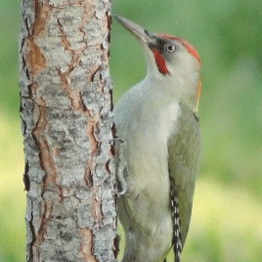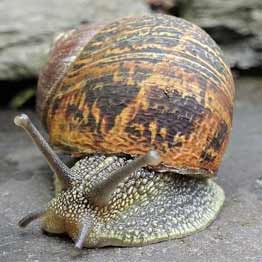
Magpie(Pica pica)
The magpie (picaraza in Navarre) is one of the best known species of the Spanish fauna, a circumstance contributed not only by its unmistakable appearance, but also by its not very demure habits and its ability to settle in highly transformed habitats, including the interior of large cities. Extremely intelligent - as corvids generally are - the magpie is to date the only bird that has been shown to be able to recognize its own image in a mirror. Like all corvids, it has a remarkable ability to emit a great variety of vocalizations, by means of which it communicates with its conspecifics. The song itself is rough and not very sonorous, with some higher notes suddenly intercalated.

Iberian Green Woodpecker(Picus sharpei)
The Iberian woodpecker is a large and robust woodpecker. Males and juveniles have a black and red moustache, which is exclusively black in females. Its flight is very characteristic, with an undulating trajectory in which the bird combines stretches in which it flaps its wings with others in which it folds them. The song of this species is unmistakable and is emitted by both males and females throughout the year. It could be defined as a kind of whinny or cackle, very sonorous, which the bird performs in a rapid sequence, lasting about two or three seconds. Contrary to other woodpeckers, it is not common for the woodpecker to use drumming as a means of communication.

Red Kite(Milvus milvus)
The red kite is a medium-sized bird of prey. In flight it is unmistakable, not only for the extraordinary skill with which it executes all kinds of maneuvers and dribbles, but also for its characteristic silhouette, with a deeply forked tail, reddish-orange in color, and long angled wings with a very visible white spot. The red kite is a "partially migratory" raptor, that is, its individuals can be both sedentary and migratory. Most of the population is migratory, with breeding areas in Central Europe and wintering areas in Spain and France. However, in both Central Europe and Spain, part of the population is sedentary, a behavior that is increasing as a result of global change. At times, it emits a sound similar to a somewhat fluttering meow, followed by ascending and descending notes.

Honey bees(Apis mellifera)
The honey bee is a social insect that lives in colonies and is distributed in three castes: the queen, which is the only fertile female; the worker bees, infertile females that are responsible for secreting wax, cleaning the hive, collecting pollen and feeding the larvae; and the drones, males whose only function is to fertilize the new queen, and do not have a stinger. Both workers and queen bees feed on royal jelly during the first three days of the larval stage. Subsequently, workers feed on pollen and nectar or diluted honey (larvae chosen to become queens continue to eat royal jelly). Bees have a great ecosystemic value since they are responsible for the pollination of most plants.

Black ant(Lasius niger)
This ant is one of the most common and one of the easiest to find near our home. It is known as the "black garden ant" and can be found all over Europe and parts of North America and Asia. It is quite shy at the beginning of the colony and when there are few members, it will only come out to forage for a worker and in a very cautious way. In case of finding insects, it will not approach them if they are very large. But once the colony settles and grows in number, their aggressiveness will grow at the same time, and they will end up being able to hunt and kill all kinds of insects. It is even common to see them raiding the nests of other Lasius niger colonies to steal their eggs, larvae and pupae and thus weaken them. Their diet is based on aphid secretions, and it is easy to find them grazing on aphids on plants in our garden or terrace. However, they are omnivorous and will also readily accept all types of insects.

Yellow butterfly(Colias croceus)
It is a widespread species throughout Europe and North Africa. In Spain and Portugal it is very frequent. It extends to Asia Minor, western India and Siberia. It is migratory, some years has producing mass migrations in Europe. It usually lives in sunny and vegetated areas, and even in cultivated areas, reaching up to a certain altitude (2000 m). They are only absent from wooded areas. It is very common in limestone mountain massifs, and less abundant, although frequent, in higher mountains, such as Sierra Nevada.

Moisture mealybug(Armadillidium vulgare)
A nocturnal and omnivorous species, it feeds mainly on decaying matter. Linked to humid areas, it shows a great plasticity to adapt to new habitats and can be found in coastal environments, cultivated land, scrubland, humid forests, pastures, urbanized environments, etc. It can go dormant to withstand the winter. It can be distinguished from other terrestrial isopods by its clearly visible antennae, which protrude when partially rolled up "like a ball".

European Paper Wasp(Polistes dominula)
They usually build their nests in eaves and shelters sheltered from the weather on the roofs of buildings and human constructions, although they can also appear in trees, under stones and other natural areas that are not very exposed to the elements. The adult wasp feeds mainly on ripe fruit. The workers feed the larvae with insects or carrion, even with specimens of their own species. They usually attack only when they perceive aggression towards their nest or in self-defense. The use of certain perfumes or creams (with pheromone-like scents) or very loud sounds (due to vibrations) or rapid and abrupt movements can also cause attacks, which may cause them to become excited.

Tipula(Tipula oleacea)
The tipula is mainly present in Europe. Its habitat extends from southern to northern Africa, but has its limit east of Algeria. It flies in early summer from April to June, (peak May-June) and there is a second generation in late summer from August to October. Small swarms, which probably serve as mating formations are formed in the evening hours when they fly close to the ground over meadows and fields. Eggs are deposited individually on loose, moist soil. Wet meadows offer this possibility, but also gardens and cultural areas are ideal for egg laying. At night, they can affect the soil parts of plants and eat the leaves. Adult animals can only take liquid food such as nectar due to their soft mouthparts.

European Garden Snail(Cornu aspersum)
It lives mainly in Europe. It is crepuscular and nocturnal, although in humid places in semi-darkness and on rainy days it is also active during the day. In times of drought it hides inside the shell and encloses itself by making a "plug" of dried mucus called epiphragm. Like most slugs and snails, it has both male and female sexual organs, so any pair of individuals can procreate. It is hermaphroditic, oviparous and has a spiral coiled calcareous shell. Famous for its slowness, it moves at a maximum speed of 0.05 km/h, in spite of which it is one of the fastest snails.
